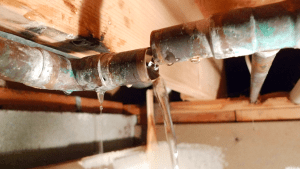This article which follows involving Leaking water lines is incredibly intriguing. You should read it.

Early discovery of leaking water lines can mitigate a possible calamity. Some little water leakages may not be visible.
1. Take A Look At the Water Meter
Every house has a water meter. Inspecting it is a proven manner in which helps you discover leaks. For starters, shut off all the water sources. Make sure no one will purge, use the faucet, shower, run the cleaning equipment or dishwashing machine. From there, most likely to the meter and watch if it will alter. Given that no one is using it, there must be no activities. That indicates a fast-moving leak if it moves. Similarly, if you identify no changes, wait an hour or more as well as inspect back once again. This implies you may have a slow leak that can even be below ground.
2. Examine Water Usage
If you detect sudden modifications, regardless of your consumption being the exact same, it indicates that you have leakages in your plumbing system. A sudden spike in your bill shows a fast-moving leakage.
A steady increase every month, even with the same practices, shows you have a slow leakage that's additionally gradually intensifying. Call a plumber to completely check your residential property, particularly if you feel a warm location on your flooring with piping beneath.
3. Do a Food Coloring Test
30% comes from commodes when it comes to water consumption. Test to see if they are running properly. Decrease specks of food color in the container as well as wait 10 minutes. There's a leak in between the tank as well as dish if the color in some way infiltrates your dish during that time without flushing.
4. Asses Exterior Lines
Don't fail to remember to examine your outdoor water lines as well. Examination faucets by affixing a yard hose. Ought to water leak out of the link, you have a loosened rubber gasket. Replace this and guarantee all connections are tight. It will certainly aid obtain it properly checked out as well as preserved yearly if you've obtained a lawn sprinkler system. One small leak can throw away lots of water as well as spike your water costs.
5. Evaluate the scenario as well as inspect
Home owners should make it a routine to check under the sink counters as well as also inside closets for any bad odor or mold and mildew development. These two red flags suggest a leakage so punctual attention is needed. Doing regular inspections, even bi-annually, can conserve you from a significant trouble.
More significantly, if you understand your house is currently old, maintain a watchful eye on your heating units, hoses, pipes and so on. Look for discolorations as well as deteriorating as a lot of pipes as well as appliances have a life expectancy. They will also naturally weaken due to damage. Don't wait for it to escalate if you believe leaking water lines in your plumbing system. Call a specialist plumber today so you do not end up with a horrible mess in your home.
Early detection of dripping water lines can minimize a potential catastrophe. Some tiny water leaks may not be noticeable. Examining it is a proven way that helps you discover leaks. One small leakage can lose bunches of water and spike your water bill.
If you think leaking water lines in your plumbing system, don't wait for it to escalate.
WARNING SIGNS OF WATER LEAKAGE BEHIND THE WALL
PERSISTENT MUSTY ODORS
As water slowly drips from a leaky pipe inside the wall, flooring and sheetrock stay damp and develop an odor similar to wet cardboard. It generates a musty smell that can help you find hidden leaks.
MOLD IN UNUSUAL AREAS
Mold usually grows in wet areas like kitchens, baths and laundry rooms. If you spot the stuff on walls or baseboards in other rooms of the house, it’s a good indicator of undetected water leaks.
STAINS THAT GROW
When mold thrives around a leaky pipe, it sometimes takes hold on the inside surface of the affected wall. A growing stain on otherwise clean sheetrock is often your sign of a hidden plumbing problem.
PEELING OR BUBBLING WALLPAPER / PAINT
This clue is easy to miss in rooms that don’t get much use. When you see wallpaper separating along seams or paint bubbling or flaking off the wall, blame sheetrock that stays wet because of an undetected leak.
BUCKLED CEILINGS AND STAINED FLOORS
If ceilings or floors in bathrooms, kitchens or laundry areas develop structural problems, don’t rule out constant damp inside the walls. Wet sheetrock can affect adjacent framing, flooring and ceilings.
https://www.servicemasterbyzaba.com/blog/how-to-detect-water-leakage-in-walls/

We hope you enjoyed our section about Leaking water lines. Thanks so much for taking time to read our short article. Sharing is nice. You never know, you may be doing someone a favor. Many thanks for your time. Please come by our blog back soon.